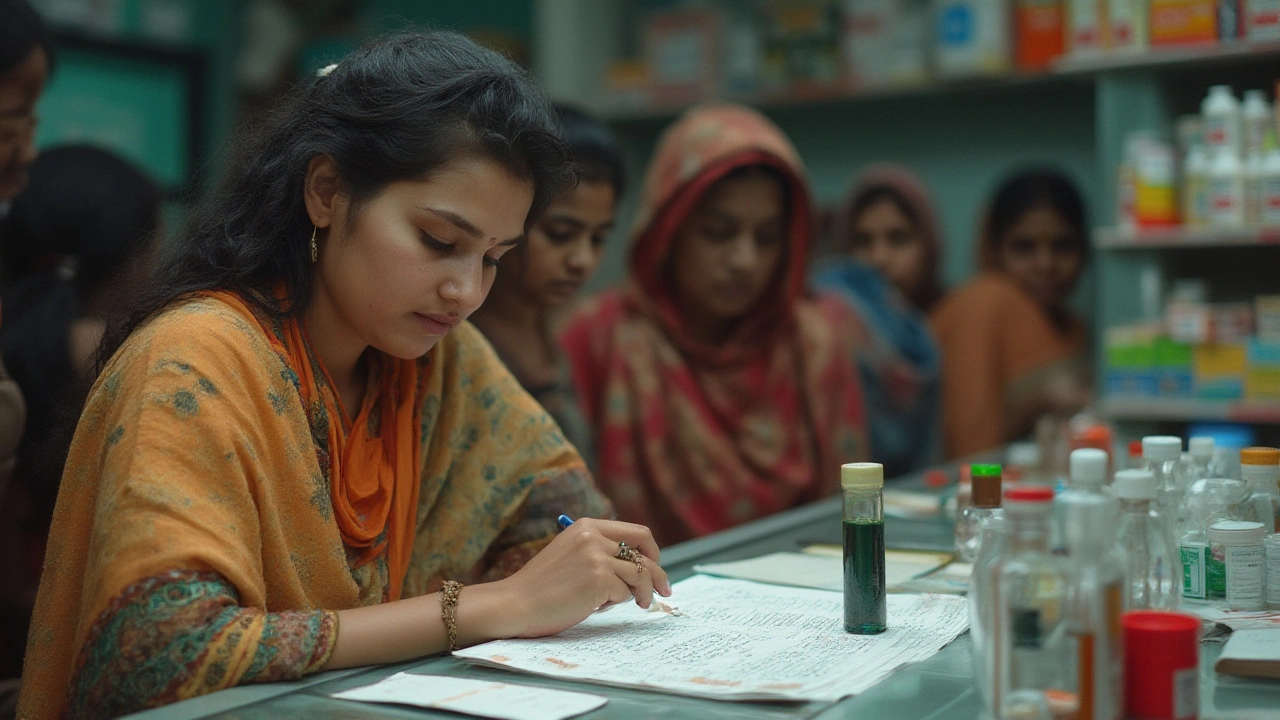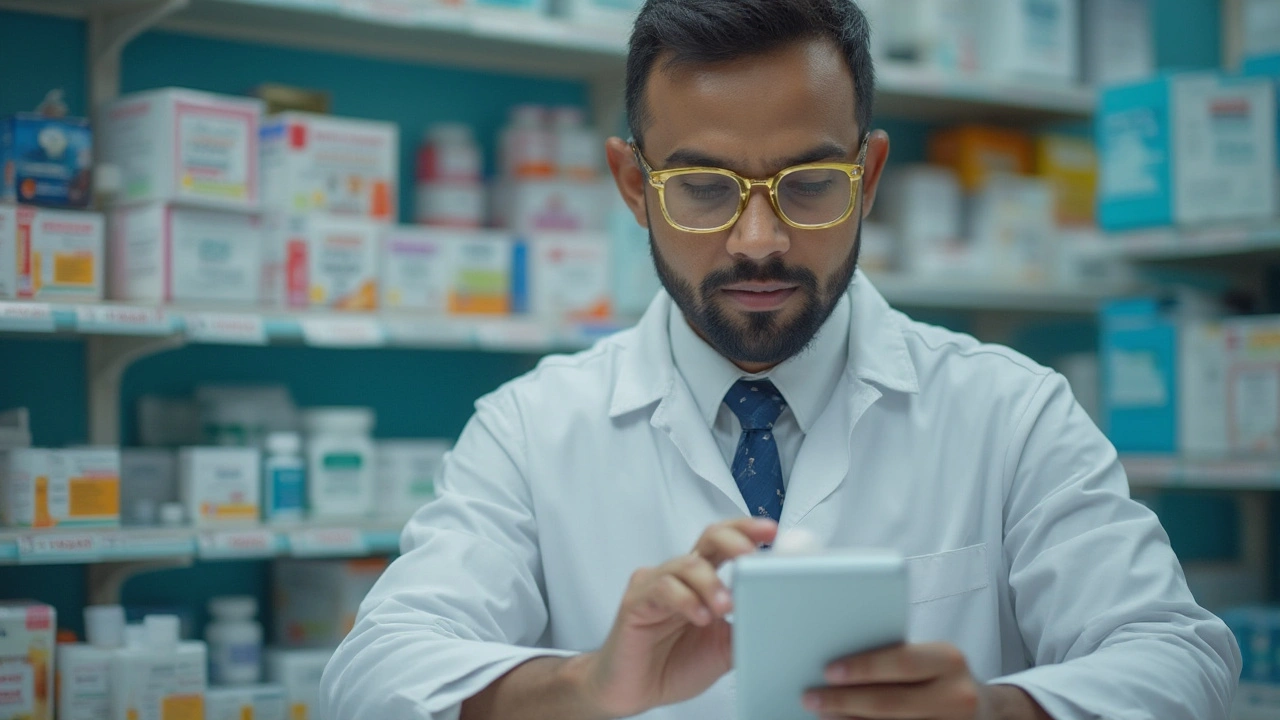How Pharmacists Read Prescriptions: Decoding Doctor Handwriting & Ensuring Medication Safety
 Jul, 18 2025
Jul, 18 2025
Ever stared at a prescription only to marvel at the squiggly, cryptic handwriting? Maybe you’ve joked about doctors taking a secret oath to make their handwriting as indecipherable as possible. Or maybe, like me, you’ve watched a pharmacist glance at that scrawl, nod knowingly, and within seconds return with the right pills. It almost feels magical. But it’s not magic—it’s training, vigilance, and a meticulous system that keeps millions of us safe every day. When my son Kian was little and sick, I remember clinging to a prescription for his fever, hoping I’d get the right medicine at the counter. Turns out, a lot goes on behind those pharmacy counters—more than anyone outside could imagine.
Why Prescriptions Are So Hard to Read
If you’ve ever tried to decipher a handwritten prescription, you know it can look downright impossible. But why is that the case? For starters, doctors are often in rush mode, with a long line of patients waiting. Quick, repetitive writing leads to shortcuts, abbreviations, and unfortunately, what looks like chicken scratch. Certain letters, especially when written quickly, end up looking like a different medication or dose altogether. There’s even a history here: research shows traditional medical school training used to encourage extensive use of Latin. That’s why you see odd terms like “qd” (once daily) or “tid” (three times daily), which add to the confusion. Combine quick penmanship with Latinized instructions, and you’ve got a recipe for cryptic notes.
It isn’t just the writing itself, but the way prescriptions are organized. A single prescription might include several medications, each with its own instructions, dosages, and route of administration—imagine cream, tablets, and syrup all on one pad. Sometimes, similar looking drug names are written with nothing more than a scribble separating one from the other; “hydralazine” versus “hydroxyzine,” for instance. According to the Institute for Safe Medication Practices (ISMP), mix-ups from lookalike and soundalike drug names cause thousands of adverse events in the US alone every year.
Why don’t doctors just use computers for prescriptions? Truth is, electronic prescribing (e-prescribing) is catching on, but handwritten notes are still common in smaller clinics, rural areas, or when there’s system downtime. Plus, some specialists still prefer writing things out. So, yes, pharmacists have to be experts in deciphering both the art and science of prescription reading.
The Art and Science of Decoding Handwriting
Pharmacists aren’t born with magical eyes, but training absolutely makes a difference. During their education, pharmacy students actually get exposed to sample prescriptions—some deliberately written as messy as possible. The idea is for them to practice identifying key elements: patient name, drug, dosage, route, and frequency. But they’re not only taught how to read the text itself; they learn to interpret context. If a doctor writes “Metoprolol” and an odd-looking dose, a pharmacist will immediately check if the prescribed amount makes clinical sense. It’s not just about recognizing a word, but understanding if the combination of drug, dose, and directions fit the patient’s symptoms, age, and health status.
Pharmacists use a clever mix of pattern recognition and medical logic. They look for drug names based on the number of syllables, common abbreviations, or even length of the scribble! Experienced pharmacists can sometimes tell you the most commonly prescribed drugs by specific doctors. For example, if Dr. Patel at the community clinic is known for using “Amoxicillin-clavulanate,” a pharmacist will expect that when they see a long scribble for ear infections. This is especially helpful when parts of the script are obscured or damaged. But guesswork only goes so far—pharmacists never hesitate to call the physician if there’s any uncertainty. This “read and confirm” habit isn’t overkill; it’s a life-saving protocol.
Here’s a fun fact: A 2017 study from the Journal of Pharmacy Practice found that the average pharmacist spends nearly 15% of their time clarifying illegible or ambiguous prescriptions. It’s not just about reading—sometimes, it’s about interpreting medical abbreviations. “OD” could mean “right eye” (oculus dexter), or “once daily” (omni die), depending on the context. Pharmacists depend on context and their knowledge of the patient’s condition.
Common Prescription Errors and How Pharmacists Prevent Them
Prescription errors are far more common than you think, and they can have real consequences. A missing decimal point, a wrong abbreviation, or a lookalike drug name can turn a standard treatment into a major health risk. The ISMP lists prescription errors as one of the top five causes of preventable medical harm worldwide. Take “0.5 mg” versus “5 mg”—if the dot is missed, that’s a ten-fold increase. There’s also the classic mix-up between “mg” (milligram) and “mcg” (microgram). So, how do pharmacists protect patients?
Every prescription goes through a detailed checking process. The pharmacist looks for five core items: right patient, right drug, right dose, right time, and right route. Imagine a mom bringing in a prescription for her toddler, but the dose seems oddly high—the pharmacist might double-check the weight-based dosing, then call the pediatrician to confirm. Pharmacists also use drug interaction checkers, review the patient’s allergy profile, and clarify any missing or messy information. Some pharmacies even have a second pharmacist review every prescription, especially those involving high-risk drugs (think blood thinners or insulin), to reduce errors further.
Modern pharmacies use electronic health records to cross-check a patient’s past medications and health history. Here’s something that blew my mind: The World Health Organization estimates that medication errors, if left unchecked, cause hundreds of thousands of deaths globally every year. That’s a sobering number and exactly why pharmacist verification matters so much.
To give you a sense of how prescription errors break down, check this:
| Type of Error | Percent of Total Errors |
|---|---|
| Illegible Handwriting | 39% |
| Wrong Dose | 22% |
| Lookalike/Soundalike Drug | 15% |
| Wrong Route | 10% |
| Incomplete Information | 14% |
Notice how legibility tops the list! Pharmacists tackle this by staying vigilant and communicating directly with prescribers when there’s any doubt at all.

How Technology Is Changing Prescription Reading
Good news: things are getting better, fast. Electronic prescribing is quickly becoming the gold standard in hospitals and even private clinics, reducing human error, removing bad handwriting from the equation, and speeding up communication. E-prescriptions are sent straight from the doctor’s system to the pharmacy, making errors less likely. A 2023 survey from the American Pharmacists Association found that pharmacies using e-prescribing saw a 67% drop in errors tied to illegible writing.
But technology isn’t a magic cure-all. Sometimes, even typed prescriptions have drop-down menu errors, sending the wrong drug or dose. And when computers go down—as they sometimes do in a power outage or cyberattack—paper scripts return. Pharmacists must stay sharp in both digital and analog worlds.
Pharmacies also use barcode systems to match the prescription to the correct drug package. Some big chain stores even use automation to count pills, which helps prevent mix-ups. Hospitals sometimes use “smart” cabinets that double-check which drugs go to which patients, confirming the match with wristbands. But none of these advances replace the pharmacist’s well-trained eye and habit for double-checking. That moment when the pharmacist calls you by name and asks, “You’re picking this up for Kian, right?” That’s not just customer service—it’s a final check in a chain of safety measures.
Tips for Patients: Making the Prescription Process Smoother
If you ever want to make things easier (for yourself and your pharmacist), there are some simple tricks. If you notice your script is especially messy or feels rushed, don’t be shy—ask your doctor to explain what’s written, or have them read it back to you. That can help if you ever need to clarify at the pharmacy. Carry a list of your medications, current and old, to help pharmacists catch interactions. If you have known allergies (especially to things like penicillin or sulfa), always mention them up front. For parents, bring your child’s weight—doses for kids are often based on weight, and having that info ready speeds up safety checks.
You should always ask the pharmacist to explain the prescription—what’s the name of the drug, what does it treat, what’s the right way to take it, and what should you look out for in side effects. Never hesitate to speak up if the pill looks different from last time, or if the instructions seem off. Pharmacists want you to ask questions—better safe than sorry! If you’re switching between pharmacies or doctors, ask for printouts or digital copies of your prescriptions; that creates a paper trail and reduces duplication or missed changes.
One last tip: time your prescription pick-up during off-peak hours, typically early mornings or mid-afternoons on weekdays, to get more attention and avoid long waits. Trust me, as a mom, that trick is gold when your kid just wants to go home and feel better.
The Pharmacy Profession: Behind-the-Scenes Heroes
Pharmacists have an odd superpower: they save lives by combining attention to detail with empathy. From deciphering that scratchy script to double-checking for dangerous drug interactions, pharmacists are way more than pill dispensers. The rules for reading scripts are strict, the margin for error is zero, and the stakes can be sky-high. Pharmacists are trained to spot not only the physical details of a prescription but the context: is this the safest option for the patient, given everything else we know?
Data from the US Bureau of Labor Statistics shows that the average pharmacist processes over 260 prescriptions per day. That’s not just matching drug names to bottles—it’s verifying directions, checking for allergies, counseling patients, and sometimes making those all-important calls back to the prescriber. There’s also emotional labor; pharmacists are often the last line of defense for families like mine, who rely on their expertise in moments of vulnerability.
Pharmacists function as health educators, too. They catch common errors (wrong name, wrong dose), but they also spot more subtle signs, like a patient picking up opioid painkillers from multiple doctors or someone using an antibiotic too often. Their training goes far beyond reading scripts. As healthcare keeps evolving, that human touch—the impulse to pause, look again, and ask questions—is what keeps us safe, even as technology changes the tools. So, next time you walk away from the counter with your meds in hand, remember you just got a dose of invisible safety, hand-delivered by someone with a sharp eye and a caring heart.
